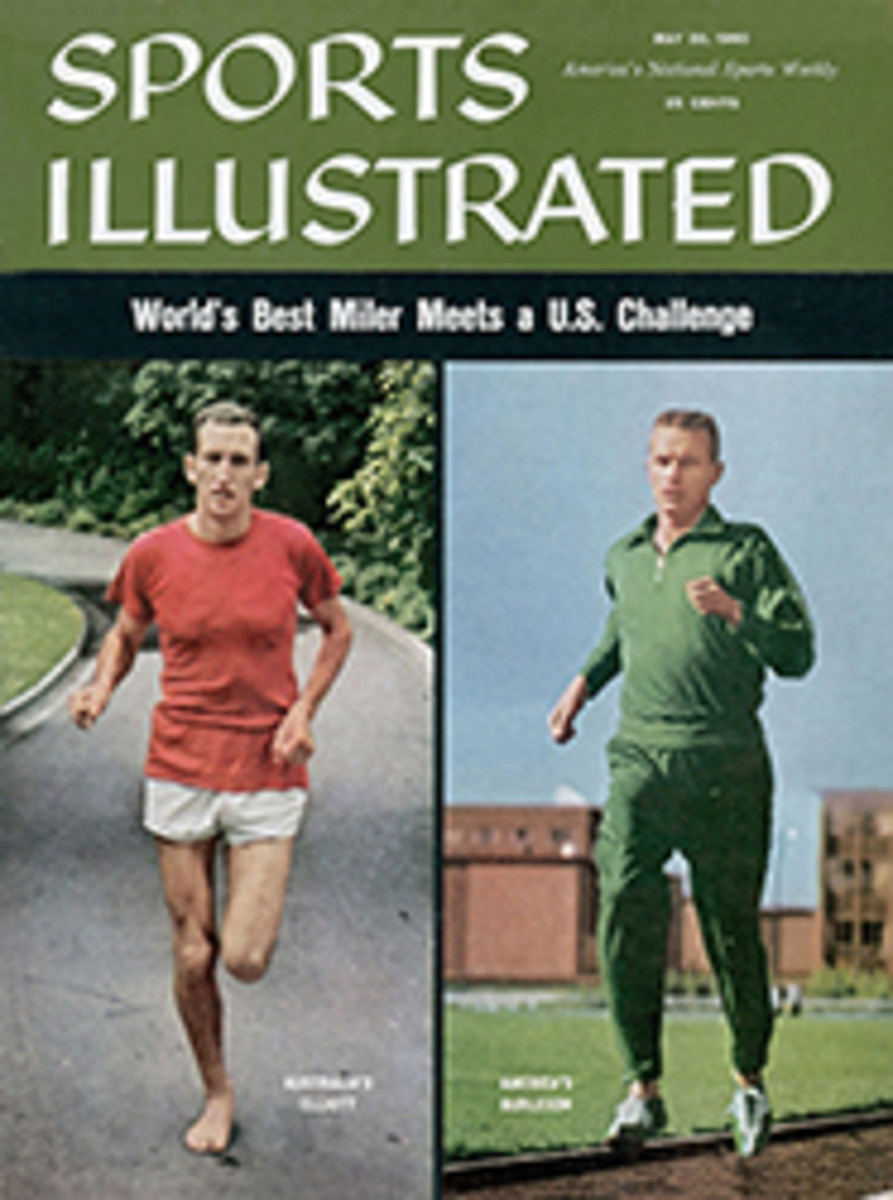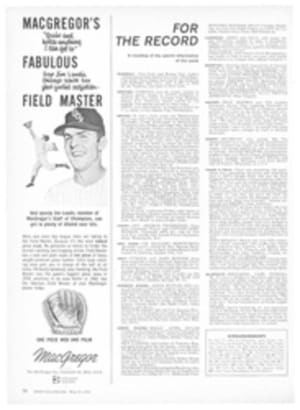
SOME DWARFS TAKE A GIANT STEP
If their brief Bermuda shorts raised British eyebrows, their American high jinks raised British hopes. They were not only the youngest (average age: 24) Curtis Cup team the U.S. had ever fielded, but the prettiest and liveliest as well. For days, as they practiced on the tricky Yorkshire course, sportswriters marveled in turn at their bright-hued American sportswear and their bantering good cheer. At times last week their relaxed air had their hosts a little worried. "They don't seem very businesslike," deprecated one no-nonsense North-Countryman in the locker room at Lindrick Golf Club. "I mean, they seem to be enjoying themselves so much."
But the experts had more concrete reasons for thinking Britain would retain its four-year hold on the cup, which was presented in 1932 by Harriot and Margaret Curtis of the U.S. for these biennial matches between women amateurs. The British team, neatly uniformed in blue sweaters and gray skirts, boasted more international veterans than the challengers. It also had more experience in foursome competition. But perhaps most important, the Americans were all first-time visitors to Britain and they were plainly discomfited by the rigors of an English spring. Two days before the start of the match, sunshine yielded to drizzle and a raw east wind. The U.S. girls changed into heavy foul-weather gear that amused the British followers no end and caused one sportswriter to say that the English had found their secret weapon.
He spoke before the weather changed. Saturday, the day the Yanks won back the trophy, was, by Yorkshire standards, positively decent. The skies were gray all right, but they were calm. The U.S. youngsters, who had played unevenly in Friday's foursomes but had come away with a 2-1 lead, tore into their singles matches with an exuberance and concentration that never wilted under pressure. They won four and tied one of their six matches on the second day to give the U.S. its largest margin of victory (6½-2½) since 1950. Boston Businessman Henri Prunaret, husband of the nonplaying U.S. captain Mildred Prunaret, beamed when it was all over and said: "They went in there like young lionesses." The London Observer added: "They played cheerfully and charmingly."
If the charm was built-in the cheer was in large measure the result of thoughtful hospitality and the excitement that most Americans feel on first discovering the green and rolling North Country. At Lindrick, the neat, narrow, immaculate course was bright with hawthorn bloom and yellow gorse. In the countryside around, as the visitors jounced to and from the course in British-supplied cars, they gaped at the luxuriance of cottage gardens, deer grazing in private parks and the pink and white splendor of huge chestnuts in full flower.
They were quartered at Barnby Moor in a hotel that looked as if it came out of a glossy British travel ad. The Olde Bell (300 years olde) was originally built as a coaching inn, and, as Anne Quast sighed, "just reeks with atmosphere." As long ago as 1690, according to a horse-borne British precursor of Duncan Hines, he found there "good harbourage and the horse good stabling." The girls soon discovered that Olde Bell "harbourage" was as good as ever. They started the day with morning tea, ate the North-Countrymen's four-and five-course lunches and dinners, downed huge quantities of sandwiches, bread and jam and plummy cake at tea, and before retiring to their rooms at night, drank rich Jersey milk. Said senior (38) Team Member Ann Casey Johnstone: "I managed to lose 12 pounds before I came over, but it's all back now."
Since most of the seven team members knew each other from previous tournaments, they formed a happy, congenial group. Wichita's Judy Bell and JoAnne Gunderson of Kirkland, Wash, dubbed the ensemble "Snow White [Mrs. Prunaret] and her seven dwarfs."
The women's national amateur champion, Barbara Mclntire, became "Grumpy,"Anne Quast "Bashful" and Judy Bell "Dopey"—"only," as JoAnne Gunderson explained, "Dopey never talked and Judy never stopped." In deference to her age and glasses, Casey Johnstone was known as "Doc." Joanne Goodwin, who had developed an allergy ("to grass, I think"), became "Sneezy." "Happy" was amiable Judy Eller of Old Hickory, Tenn. JoAnne Gunderson was "Sleepy."
Physically and temperamentally, the team was as varied as the nicknames suggest. Florida's Barbara Mclntire, 25, is hazel-eyed and handsome, with short brown curls and dimples that belie her steely, aggressive brand of golf. JoAnne Gunderson, who was U.S. women's national amateur champion in 1957 at 18, is a big (5 feet 7 inches) blue-eyed blonde with strength and staying power inherited from her Norwegian ancestors; A fellow Washingtonian is bright Stanford graduate Anne Quast, who beat out Gunderson for the title in 1958. Brunette Judy Bell, the 23-year-old daughter of a meat dealer, hints that she plans to get married. Pretty Joanne Goodwin was the team's quietest member and its smallest (5 feet 2½ inches). And 19-year-old Judy Eller, a lanky (5 feet 8½ inches), loose-limbed physical education major at the University of Miami, is the team's youngest and tallest member. Best-prepared was Casey Johnstone, a graying Mason City, Iowa housewife, who boned up for the tournament by immersing herself in a film of the course that an Iowa priest obligingly shot for her on a trip to Europe.
EARLIER AND TOUGHER
What the American golfers had in common, in contrast to the older British team, was a toughness born of wider competitive experience at home. The "American golf amazons," as the Sheffield Telegraph un-gallantly labeled them, have also probably played golf from a tenderer age than their opponents. Anne Quast's family owns a golf course, and two of the girls—Goodwin and Eller—are-daughters of professional golfers. Paternal patience has been well rewarded in their smooth, controlled style and deep concentration. This was also so of chain-smoking Barbara Mclntire, who battled down to the last putt with the 37 year-old British champion, Elizabeth Price. Steadily whittling away at her opponent's lead, Barbara rolled in a 15-foot putt at the 35th hole and ended in a dead heat. The most brilliant golf in the singles was played by JoAnne Gunderson, whose huge drives and low, precise pitches beat three-time Curtis Cup veteran Angela Bonallack, 2 and 1. The most promising U.S, player was Judy Eller, whose crisp style and steady game brought her a 4 and 3 victory over Philomena Garvey, a 32-year-old veteran of five previous Curtis Cup matches.
After a last, massive breakfast at the Olde Bell, the U.S. girls left to watch the British Ladies' Open Amateur Championship at Harlech in Wales. "We've made so many good friends among British players," explained Mrs. Prunaret, "we 'have to see how they do."
PHOTO
"SNEEZY"
PHOTO
"DOPEY"
PHOTO
"BASHFUL"
PHOTO
"GRUMPY"
PHOTO
"HAPPY"
PHOTO
"SLEEPY"

